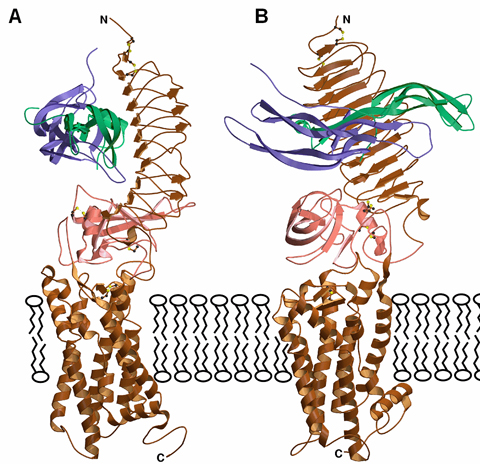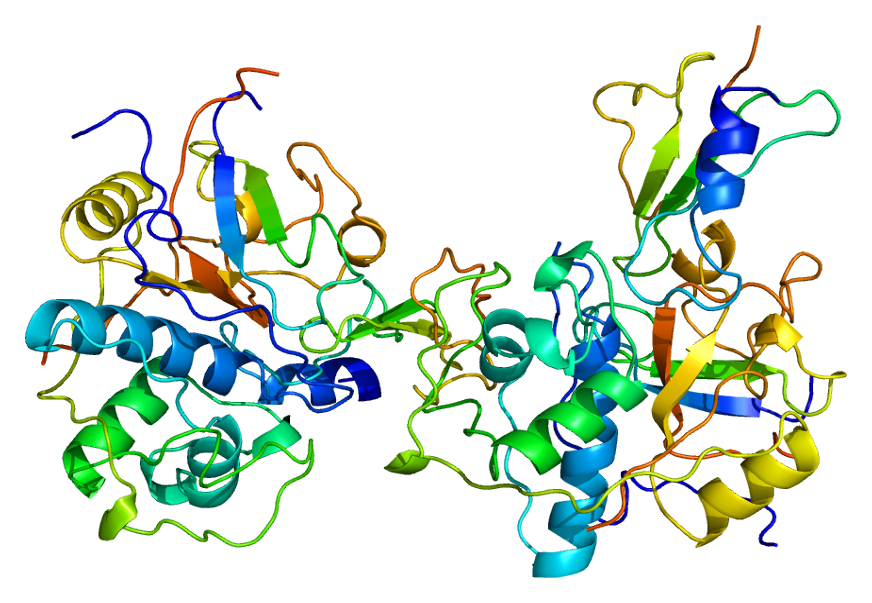General Biology 2, lecture on Chemical Messengers
XI. Chemical Messengers: the Endocrine System
A. Endocrine glands
1. neurons (neurosecretory neurons)
a. in hypothalamus - Releasing Hormones (RH, e.g. TRH, GnRH)
b. also hypothalamic, but with axons to posterior pituitary
- Oxytocin and AVP
c. pineal - melatonin
d. modified (glandular) medulla of adrenal gland
- epinephrine (Epi), norepinephrine (NE)
2. glands
a. pituitary - tropic hormones (= stimulating hormones\SHs
e.g. TSH, FSH, LH)
b. thyroids/parathyroids - thyroxin (T4),
parathyroid hormone
c. thymus, heart - thymulin, atrionatriuretic factor (ANF)
d. gastrointestinal tract, pancreas - motilin, insulin
e. kidneys and liver - renin ® angiotensin
f. adrenal cortex - cortisol, aldosterone
g. gonads (ovaries, testes) - estrogens (E), testosterone (T)
h. placenta - progesterone (P), chorionic gonadotropin (hCG)
3. Plants
a. shoot apex - auxins (IAA, NAA, IBA), gibberellins (GA; growth)
b. roots - cytokinins (CK, zeatin; cell division)
c. everywhere - ethylene (ripening, opening flowers, senescence)
abscisic acid (AbA; stress, dormancy)
B. Hormones
1. peptides, glycoproteins, proteins - RHs, SHs, insulin
2. modified amino acids - thyroxin, Epi, NE
3. steroids (fat) - T, E, P, cortisol
a. steroids made in the brain - THDOC, allopregnanolone, DHEA-S
C. Blood
1. all animal hormones are secreted into the blood (endo = inside)
a. often protected by carrier or binding proteins
2. other types of regulatory biochemicals are not
secreted into the blood
a. paracrines/autocrines ® extracellular space
i. secreted by and affects the adjacent/same cell
(1) e.g. prostaglandins (PGs)
ii. neurotransmitters ® synaptic cleft
b. exocrines or pheromones - via ducts outside
i. e.g. sweat, uteroglobin, estrogens
3. plant hormones are endocrines, paracrines and exocrines
4. travel to target tissue
a. bind to receptors
i. proteins in the membrane
(= receptor for peptide/protein hormones)
ii. proteins in the cytoplasm or nucleus
(for steroid & thyroid hormones)
D. Common Endocrine Secretion Pattern (example: Thyroid Endocrine Axis)
1. Hypothalamus
a. Physiological or psychological stimulus causes the
secretion of Releasing Hormones
i. eg. cold = stimulus
(1) TRH = releasing hormone
2. secreted into a capillary bed
a. portal vessel
3. Pituitary (Hypophysis)
a. capillary bed
b. anterior lobe of the pituitary (yes there is a posterior lobe)
c. Releasing hormone causes release (what else) of a tropic hormone
i. e.g. TRH causes release of TSH
= Thyroid Stimulating Hormone
d. released into another capillary bed
4. Gland (Thyroid)
a. tropic hormones stimulate release of hormone
i. e.g. TSH causes the release of T4 / T3 from the thyroid gland
b. travels via the blood to the target tissue
i. target tissue has receptors (e.g. T3-R)
ii. e.g. T4 / T3 works on all tissues
to ñ metabolic rate
5. negative feedback inhibits the over-production of hormones
E. Homeostasis
1. Feedback
a. hormone from the gland (T3) binds to receptor (T3-R)
in the hypothalamus and inhibits releasing hormone (TRH)
b. hormone (T3) binds to receptor (T3-R)
at the pituitary and reduces tropic hormone (TSH) secretion
c. i.e. T3 inhibits TRH & TSH
2. Short feedback loop
a. tropic hormone binds to receptor (TSH-R) in the hypothalamus
and inhibits releasing hormone (TRH)
3. Ultrashort feedback
a. releasing and tropic hormones reduce their own output
i. e.g. TSH inhibits TSH
ii. TRH inhibits TRH
F. Synergisms
1. One stimulus may cause the release of more than one hormone
a. cold is a stress and stimulates the release of
cortisol from the adrenal cortex
2. The release of one hormone may enhance
the release of another hormone
a. Cortisol is necessary for the production of epinephrine
and when present increases production rate
3. Two hormones may have similar, additive or inhibitory effects
on the target tissues or the organism as a whole
a. Epi and T4 increase metabolic rate
b. AbA/GA ratio: AbA È seed dormancy ð GA È germination
G. Mechanisms of Hormone action
1. a hormone binds only
where there are specific RECEPTORS = target tissue
2. receptors for peptides are on the cell membrane
a. the receptor is connected to a G protein
b. G-protein sends the signal to a 2nd messenger system
example:
c. Gs ® AC (adenylate cyclase) ® cAMP ® PKA (protein kinase A)
PKA ðñ CREB ðñ CRE
d. a Protein Kinase phosphorylates
(takes P and energy from ATP and adds it to)
enzymes and trancription factors (TFs), which makes them active
e. active enzymes and TFs turn on the cell response
3. steroids and thyroid hormones bind to
cytoplasmic or nuclear receptors
a. hormone + nuclear receptor complex binds to and
stimulate transcription of DNA to make mRNA
i. TFs (like CREB) also bind DNA response elements (like CRE)
b. mRNA binds with ribosomes to make new proteins
(including enzymes)

